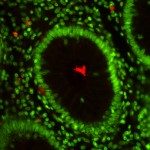Lien vers Pubmed [PMID] – 15030306
Crit. Rev. Immunol. 2003;23(5-6):371-401
Acute infectious colitis remains a major pediatric issue of worldwide impact because it still represents a significant public health burden among the larger group of diarrheal diseases with the highest mortality rate. It is also a relevant model of inflammatory bowel diseases (IBD), such as Crohn’s disease and ulcerative colitis. Among cases of acute colitis of infectious origin, shigellosis is certainly the one that has benefited the most from a significant research effort. Shigella, the causative agent, is a Gram-negative bacterium that has the capacity to invade, disrupt, and cause inflammatory destruction of the intestinal epithelial barrier. The molecular and cellular bases of this invasive phenotype essentially encompass crossing of the epithelial lining, apoptotic killing of macrophages, entry into epithelial cells, and escape into the cytoplasm, followed by cell-to-cell spread. Intracellular colonization is likely to protect the micro-organisms from killing by humoral and cellular effectors of the innate immune response. Concurrently, the capacity of Shigella to reprogram invaded epithelial cells to produce proinflammatory mediators plays a major role in the strong inflammatory profile of the disease. This profile is likely to impact on the nature and quality of the adaptive response, which is dominated by humoral protection at the mucosal level.

